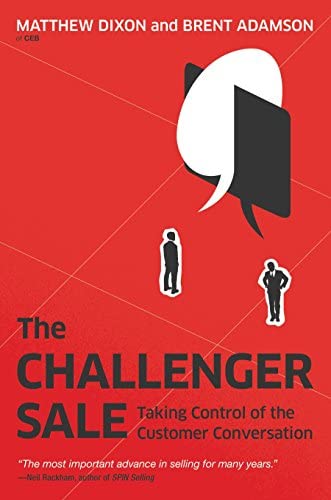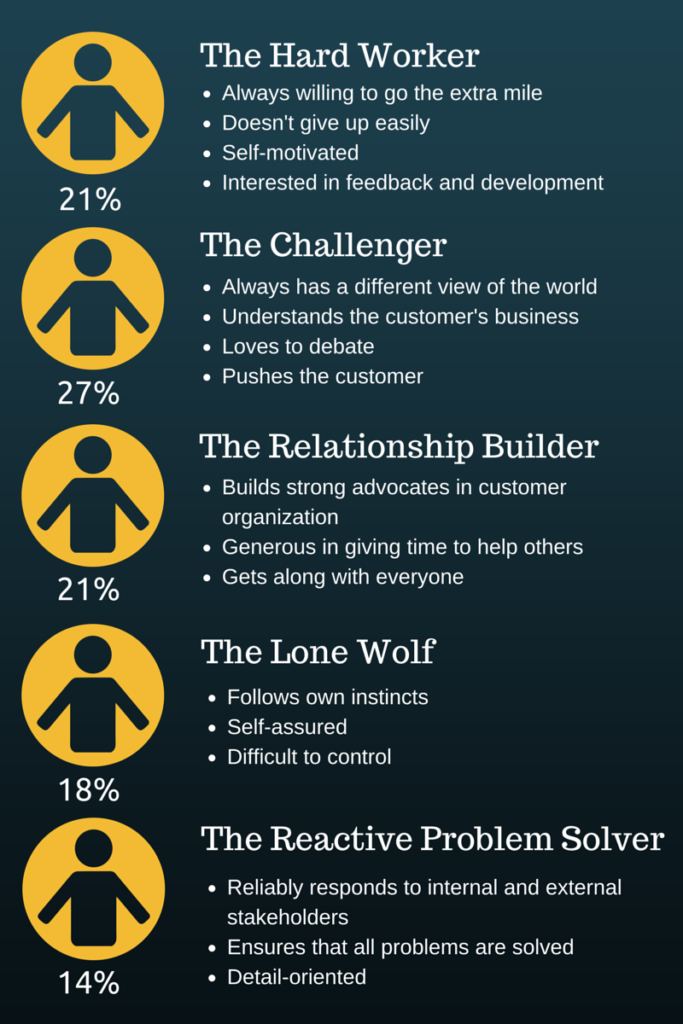
The Challenger Sale – เทคนิคสำคัญที่นักขายยุคนี้ต้องรู้และเข้าใจ โดยเฉพาะต้องเป็นนักขายท่ามกลางการเปลี่ยนแปลงต่างๆ และความไม่แน่นอน ไม่ว่าจะเป็นพฤติกรรมของลูกค้าที่เปลี่ยนแปลงความต้องการไว หรือ การแข่งขันที่นับวันก็ร้อนระอุมากขึ้นทุกที
ในยุคที่วิกฤตเศรษฐกิจกับวิกฤตการระบาดของโควิด-19 กำลังแข่งกันทวีความรุนแรงเช่นนี้ ธุรกิจเป็นเหมือนรายการเอาตัวรอด ที่ใครเก่ง ใครฉลาด ใครมีไหวพริบ หรือใครดวงดี คนนั้นรอด ดังนั้นถ้าหากคุณมีกลเม็ดเคล็ดลับในการดำเนินธุรกิจที่ดีเป็นเหมือนการที่คุณมีไอเท็มราคาแพงในการทำให้คุณผ่านด่านในเกมนี้ไปอีกไกล แน่นอนว่าคุณอาจจะขึ้นเป็นที่หนึ่งในเกมนี้ของคุณเลยก็ได้
คุณกำลังค้นหาเทคนิคที่รับประกันว่ายอดขายของบริษัทคุณจะดีขึ้นใช่ไหม? หรือ คุณกำลังมองหาสื่อที่เหมาะสมสำหรับการฝึกอบรมทีมขายของคุณหรือเปล่า? หรือ คุณต้องการรู้ว่าลูกค้ามองธุรกิจของคุณอย่างไรบ้าง?

หนังสือ The Challenger Sale เขียนโดย Matthew Dixon กรรมการบริหารของ The Corporate Executive Board Company ซึ่งเป็นบริษัทที่ปรึกษาชั้นนำของโลก โดยหนังสือเล่มนี้ได้เขียนร่วมกับ Brent Adamson กรรมการผู้จัดการบริษัทและหัวหน้านักเล่าเรื่อง หลังจากตีพิมพ์หนังสือเล่มนี้กลายเป็นที่พูดถึงในทันที ว่านี่คือตำราที่จะสอนวิธีการดำเนินธุรกิจอย่างมีจุดยืน และจะสอนกลยุทธ์การขายที่องค์กรชั้นนำทั่วโลกใช้ หากคุณอยากเป็นนักขายที่ประสบความสำเร็จ ตอนนี้คุณเลือกหนังสือได้ถูกเล่มแล้ว
“ในโลกของพฤติกรรมการซื้อของลูกค้าที่เปลี่ยนแปลงไปอย่างรวดเร็ว และความสามารถในการขายที่ต่างกันอย่างรวดเร็ว ทำให้แนวทางการขายของคุณต้องพัฒนา ไม่เช่นนั้นคุณจะถูกทิ้งไว้ข้างหลัง”
เศรษฐกิจในปัจจุบันเปลี่ยนแปลงไปเร็วราวกับลมพัด เหล่าธุรกิจที่ยังโลดแล่นอยู่ในตลาดจึงจำเป็นต้องมีเทคนิคใหม่ๆ ที่พร้อมปรับให้เข้ากับสถานการณ์ปัจจุบันอยู่เสมอ ในปี 2552 โลกเผชิญกับภาวะเศรษฐกิจตกต่ำครั้งใหญ่ การดำเนินธุรกิจในท้องตลาดจึงเต็มไปด้วยความสับสนวุ่นวาย จึงทำให้ยอดขายทุกบริษัทตกต่ำลงอย่างไม่ต้องสงสัย แต่ในขณะที่หลายบริษัทมียอดขายตกต่ำ ก็ยังมีบางบริษัทที่สามารถทำยอดขายได้มากกว่าที่เคย สิ่งเหล่านี้จึงกระตุ้นให้เกิดการวิจัยขึ้น
“นักแสดงดาวเด่นมีผลงานเหนือกว่านักแสดงหลักเกือบ 200%”
การขายในลักษณะนี้จะเปิดเผยผู้ชนะในการทำงานอย่างชัดเจน เราจะเห็นเลยว่าใครคือนักขายผู้ชนะ เพราะการทำงานลักษณะนี้เราจะเห็นผลลัพธ์ได้อย่างชัดเจน แต่ผลลัพธ์กลับกลายเป็นเรื่องยากที่จะเชื่อได้เมื่อมองจากกระบวนการทำงาน จากงานวิจัยพบว่าธุรกิจจากบริษัทที่มีโปรไฟล์ชั้นเลิศไม่ได้ทำให้พวกเขาชนะ กลับกัน ผู้ชนะในตลาดนี้กลับการเป็นเพียงผู้ท้าชิง หรือบางครั้งอาจจะเป็นผู้ท้าชิงหน้าใหม่ในตลาดด้วยซ้ำ
“เทคนิคการขายแบบดั้งเดิม อาจจะใช้ไม่ได้ผลอีกต่อไป”
โลกแห่งการขายเป็นโมเดลธุรกิจที่พัฒนาขึ้นเรื่อยๆ มีข้อมูลบ่งชี้ว่าจำเป็นต้องมีชุดทักษะเฉพาะของ ตัวแทนขายเพื่อเพิ่มยอดขาย จากที่เคยมุ่งเน้นการขายผลิตภัณฑ์แต่ละรายการ การขายโดยทั่วไปจะเริ่มเข้าสู่การมุ่งเน้นที่การขายแบบให้คำปรึกษาของกลุ่มผลิตภัณฑ์และบริการต่างๆ ที่ขายออกไปด้วย วิธีการนี้ประสบความสำเร็จมาแล้วเนื่องจากตอบสนองความต้องการของลูกค้าในวงกว้าง ซึ่งคู่แข่งไม่สามารถทำซ้ำได้ง่ายๆ การขายในลักษณะให้คำปรึกษาควบคู่ไปด้วยมักเป็นที่ต้องการอย่างมาก เพราะลูกค้ามักซื้อสินค้าเพื่อแก้ปัญหาอันซับซ้อนในชีวิตจริง พวกเขาไม่ได้อยากได้เพียงแค่ตัวสินค้า แต่พวกเขาได้วิธีที่จะใช้สินค้าในการแก้ไขปัญหาของพวกเขาด้วย
“ตัวแทนขายมีทักษะที่หลากหลาย คุณจำเป็นต้องผสมผสานทักษะเหล่านี้อย่างมีประสิทธิภาพ เพื่อความสำเร็จของธุรกิจของคุณ”
ตัวแทนขายทั้งหมดไม่ได้ทำงานในรูปแบบหรือระบบเดียวกัน จึงเป็นเรื่องยากที่คุณจะหาตัวแทนขายนักแสดงดาวเด่นและตัวแทนขายนักแสดงหลัก สิ่งที่คุณต้องทำคือพยายามจดจำทักษะที่หลากหลายของพวกเขาและนำพวกเขาทั้งหมดไปสู่ความเป็นเลิศระดับเดียวกัน
จากการสำรวจทัศนคติและกิจกรรมของผู้จัดการฝ่ายขายแนวหน้าหลายพันคนในบริษัท 90 แห่งทั่วโลก แสดงให้เห็นข้อมูลสำคัญดังต่อไปนี้
การวิเคราะห์ปัจจัยต่างๆ จากข้อมูล พบว่ามีทั้งหมดตัวแทนขายแบ่งออกได้ 5 ประเภทด้วยกัน คือ

- คนทำงานหนัก (21% ของกลุ่มตัวอย่าง) พวกเขาทุ่มเทให้กับงาน พยายามอย่างเต็มที่เพื่อบรรลุเป้าหมาย
- ผู้ท้าชิง (27% ของกลุ่มตัวอย่าง) พวกเขามีความเข้าใจอย่างลึกซึ้งในธุรกิจของลูกค้าและไม่กลัวที่จะแบ่งปันความคิด พวกเขามีความแน่วแน่และผลักดันให้ลูกค้าลองสิ่งใหม่ๆ
- หมาป่าเดียวดาย (18% ของกลุ่มตัวอย่าง) พวกเขามีความมั่นใจในตัวเองมาก และดูถูกกฎเกณฑ์ มักจะปฏิบัติตามสัญชาตญาณเสมอ
- ตัวสร้างความสัมพันธ์ (21% ของกลุ่มตัวอย่าง) พวกเขาทั้งหมดมักยุ่งอยู่กับการสร้างความสัมพันธ์ส่วนตัว อาชีพที่แข็งแกร่งและตอบสนองความต้องการของลูกค้า
- ตัวแก้ปัญหา (14% ของตัวอย่าง) มีความน่าเชื่อถือสูงและใส่ใจในรายละเอียด
แม้ว่าตัวแทนขายหลายคนจะไม่มีทักษะแค่ประเภทเดียวจาก 5 ประเภท บางคนอาจจะมีความคิดสร้างสรรค์ แนะนำให้ลูกค้าลองสิ่งใหม่ๆในขณะที่พวกเขาก็ชอบที่จะสร้างความสัมพันธ์อันดีกับคนรอบข้างเสมอด้วย แต่ 5 ประเภทนี้จะถูกจำแนกโดยใช้ทักษะที่พวกเขามีมากที่สุดมาเป็นเกณฑ์
ผู้ชนะที่ชัดเจน 1 ราย และผู้แพ้ที่ชัดเจน 1 ราย: การค้นพบทั้ง 2 สิ่งนี้แสดงให้เห็นว่าเมื่อเปรียบเทียบพฤติกรรมเหล่านี้กับประสิทธิภาพการขายจริง ผู้ท้าชิงทำผลงานได้ดีกว่าคนอื่นๆ และผู้สร้างความสัมพันธ์ก็ล้าหลังอย่างมาก ผู้ท้าชิงสามารถสอน ปรับแต่ง และควบคุม สิ่งเหล่านี้ทำให้พวกเขาแตกต่างจากอีก 4 ประเภทที่เหลือ ผู้ท้าชิงมุ่งเน้นไปที่การนำลูกค้าออกจากสิ่งเดิมๆ และมองหาทางใหม่ที่สร้างสรรค์กว่า
ผู้ท้าชิง คือตัวแทนขายที่แก้ปัญหาได้ ไม่ใช่แค่ตัวแทนในช่วงเวลาที่เศรษฐกิจตกต่ำ:ในการขายที่ซับซ้อน ผู้ท้าชิงมีอำนาจเหนือกว่าประเภทอื่นๆ นอกจากนี้ มากกว่า 50% ของตัวแทนขายทั้งหมดกลุ่มเดียวที่ใกล้เคียงกับผู้ท้าชิงมากที่สุด คือหมาป่าเดียวดาย
“หากคุณกำลังพยายามสร้างแนวทางที่เน้นคุณค่าหรือมุ่งเน้นการแก้ปัญหามากขึ้น คุณต้องมีตัวแทนฝ่ายขายที่ไม่เพียงแต่ท้าทายลูกค้าให้ดีขึ้นเท่านั้น แต่ยังเข้าใจด้วยว่าความสำเร็จมีความหมายต่อทุกคนอย่างไร?”
หลักการของนักขาย “ผู้ท้าชิง”
- ผู้ท้าชิงไม่ได้มีแค่คนเดียว ตัวแทนขายทุกคนสามารถได้รับการฝึกฝนให้เป็นผู้ท้าชิงได้ สิ่งที่คุณต้องมีคือสื่อการฝึกอบรมที่เหมาะสมกับพวกเขา
- ความท้าทายเป็นเรื่องเกี่ยวกับความสามารถขององค์กร ไม่ใช่แค่ทักษะตัวแทน การเปลี่ยนแปลงไปยังโมเดลการขายของผู้ท้าทายไม่ใช่แค่การพัฒนาทักษะตัวแทนแต่ละคนเท่านั้น แต่ต้องพัฒนารูปแบบการทำงานและความสามารถขององค์กรด้วยเช่นกัน
- การสร้างทีมขายของผู้ท้าชิงเป็นการเดินทางระยะยาว ไม่ใช่การเดินทางข้ามคืน โมเดลผู้ท้าชิงต้องการการเปลี่ยนแปลงทั้งในด้านความสามารถขององค์กร พฤติกรรมและทักษะของตัวแทนแต่ละคน และอาจต้องใช้เวลาหลายปีในการทำงานอย่างหนัก
ด้วยวิธีที่ผู้ท้าชิงเป็นการสอนลูกค้าในสิ่งใหม่ๆ ที่ทำให้พวกเขาแตกต่างจากคู่แข่ง ปรับแต่งข้อความการสอน และรักษาการควบคุมระหว่างการขาย ลูกค้าจะเชื่อมั่นได้เร็วขึ้น ทำให้พวกเขาประสบความสำเร็จมากที่สุด
“รู้หรือไม่ 87% ของเนื้อหาการฝึกอบรมการขายจะถูกลืมภายในสามสิบวัน”
ข้อมูลที่คุณต้องการ คือชุดของความต้องการทั่วไปของลูกค้า หากต้องการเอาชนะใจลูกค้า คุณต้องสอนสิ่งใหม่ๆให้พวกเขาและเพื่อเป็นนักขายที่ประสบความสำเร็จ คุณต้องเป็นไปตามเกณฑ์ต่อไปนี้
4 ขั้นตอนในการนำเอาชนะใจลูกค้า
- หาจุดแข็งของตัวเองให้เจอ สำหรับการสอนเพื่อสร้างผลกำไร คุณต้องแน่ใจว่าคุณสามารถแก้ปัญหาของลูกค้าได้ และคุณมีทักษะที่จำเป็นในการทำสิ่งนั้น
- ต้องท้าทายความต้องการของลูกค้า เมื่อคุณต้องสอนหรือแก้ปัญหาบางอย่างให้กับลูกค้า มันต้องท้าทายความคิดเริ่มต้นของพวกเขาและเข้าถึงโลกของพวกเขาในแบบที่พวกเขาไม่เคยคิดหรือชื่นชมอย่างเต็มที่มาก่อน เมื่อคุณทำตามที่พวกเขาต้องการได้ คุณจะประสบความสำเร็จในการขายครั้งนี้
- ต้องกระตุ้นการดำเนินการ การเปลี่ยนวิธีคิดของลูกค้าไม่เพียงพอ คุณต้องให้พวกเขาลงมือทำด้วย แต่ก่อนที่จะซื้ออะไร ลูกค้าต้องเข้าใจก่อนว่าเพราะอะไรมันถึงแก้ปัญหาของพวกเขาได้ คุณทำได้โดยอาจจะช่วยลูกค้าคำนวณต้นทุนที่เกิดขึ้นหรือผลตอบแทนที่พวกเขาจะได้รับ พวกเขาจะละทิ้งหลักการของตัวเองแล้วหักเหตามที่คุณแนะนำ
- ต้องปรับเปลี่ยนตามลูกค้า คุณต้องการข้อมูลเชิงลึกอันทรงพลังจำนวนเล็กน้อยที่ใช้ได้กับกลุ่มลูกค้าที่กว้างที่สุดเพื่อให้คุณมีฐานลูกค้าที่แน่น ดังนั้นคุณต้องรู้จักที่จะปรับตัวให้เข้ากับพวกเขาเพื่อต่อยอดหาทางหรือวิธีที่เหมาะสมกับพวกเขาที่สุด
การนำเสนอผลงานที่ประสบความสำเร็จไม่ใช่การพูดถึงแต่ความรู้ทางเทคนิคที่เท่านั้น แต่ยังรวมถึงองค์ประกอบทางอารมณ์ด้วย คุณต้องเล่าเรื่องที่มีความสงสัยและแปลกใจเล็กน้อย ต่อไปนี้คือ 6 ขั้นตอนในการนำเสนอผลงานระดับโลกที่ใช้ได้ผล
6 ขั้นตอนในการนำเสนอผลงานระดับโลก
- หลังจากการพูดเปิดเบื้องต้นแล้ว ให้ประเมินปัญหาของลูกค้าด้วยตัวเองแทนที่จะถามพวกเขา แล้วแก้ไขปัญหาโดยตรง การทำเช่นนี้จะสร้างความน่าเชื่อถือของคุณ
- แนะนำมุมมองใหม่ที่เชื่อมโยงความท้าทายเหล่านั้นกับปัญหาใหญ่กว่าที่พวกเขายังคิดไม่ถึง
- นำเสนอข้อมูลที่แสดงให้เห็นว่าคุณสามารถเพิ่มผลตอบแทนจากการลงทุนของพวกเขาได้อย่างไร และเหตุใดการแก้ปัญหาที่คุณนำเสนอถึงสามารถช่วยพวกเขาให้รอดพ้นจากการสูญเสียอื่นๆ หรือการลงทุนที่ไม่ดี
- ให้แน่ใจว่าคุณเชื่อมโยงวิธีแก้ปัญหาของคุณกับปัญหาของพวกเขาได้ และอย่าลืมเชื่อมต่ออารมณ์กับลูกค้าแต่ละรายผ่านทักษะการเล่าเรื่องของคุณด้วย
- โน้มน้าวพวกเขาถึงวิธีแก้ปัญหาที่คุณเสนอและทำให้พวกเขาแน่ใจว่ามันคือทางที่ดีที่สุด
- อธิบายว่าคุณจะนำวิธีแก้ปัญหามาสู่ชีวิตได้อย่างไร? ขั้นตอนที่เกี่ยวข้องและสิ่งที่จำเป็นที่คุณต้องทำ
“ลูกค้าทุกคนมีเอกลักษณ์เฉพาะตัว และคุณต้องเข้าใจสิ่งนี้จึงจะสามารถตอบสนองพวกเขาได้ทั้งหมด”
ลูกค้าจะตอบแทนคุณด้วยความภักดีเมื่อคุณสอนสิ่งที่พวกเขาเห็นคุณค่า ไม่ใช่แค่ขายสิ่งที่พวกเขาต้องการเท่านั้น คุณควรจำไว้เสมอว่าไม่ใช่แค่ผลิตภัณฑ์และบริการที่คุณขายเท่านั้น แต่มันคือข้อมูลหรือวิธีการที่มีคุณค่ากับพวกเขาบวกเข้ากับการนำเสนอซึ่งเป็นส่วนหนึ่งของการโต้ตอบการขาย ตัวแทนขายที่ฉลาดจะมีวิธีการปรับแต่งข้อความการขายเพื่อสร้างความพึงพอใจให้แก่ลูกค้าและได้ใจลูกค้ามาในที่สุด
“ความคิดที่ยิ่งใหญ่ คือการที่เรากำลังขอให้บริษัทของเราและลูกค้าของเราเสี่ยงครั้งใหญ่ในการนำแนวคิดของเราไปใช้”
ผู้ท้าชิงมักจะควบคุมการขายตั้งแต่ต้นจนจบ พวกเขามีความมั่นใจเพราะพวกเขาเชื่อมั่นในคุณค่าที่พวกเขาเสนอให้กับลูกค้า แม้ว่าเราจะไม่สามารถเปลี่ยนพฤติกรรมของมนุษย์ได้จริงๆ แต่เราสามารถเสนอเครื่องมือที่ใช้งานได้จริงเพื่อให้แน่ใจว่าพวกเขาจะไม่ยอมแพ้ก่อนเวลาอันควรได้ ผู้ท้าชิงจะพูดคุยเรื่องเกี่ยวกับเงินและคุณค่าของสิ่งที่พวกเขาเสนออย่างสบายใจและสามารถดึงลูกค้าออกจากกรอบเดิมๆได้
นอกจากนี้ยังมีกรอบการทำงาน 4 ขั้นตอนที่ออกแบบมาเพื่อลดแนวโน้มการให้ลูกค้ามากจนเกินไปของตัวแทนขาย ดังต่อไปนี้
- รับทราบและเลื่อนเวลา: ในการตอบสนองต่อการประท้วงของลูกค้าเกี่ยวกับราคาของสินค้า คุณสามารถพูดว่า “ฉันเข้าใจว่าราคายังดูไม่เหมาะสม แต่ก่อนที่เราจะทำ ฉันขอใช้เวลาสักครู่เพื่อให้แน่ใจว่าฉันเข้าใจความต้องการของคุณอย่างแท้จริง”
- ให้ลึกและกว้างขึ้น: เปิดเผยความต้องการพื้นฐานของลูกค้า ตัวอย่างเช่น “คุณต้องการอะไร หากได้ลดราคา 30%”
- สำรวจและเปรียบเทียบ: วิธีนี้จะเปรียบเทียบและประเมินความต้องการเพิ่มเติมที่ระบุในระหว่างการสนทนา ตัวอย่างเช่น “จะเกิดอะไรขึ้นถ้าเราเพิ่มการรับประกันให้เป็นที่ยอมรับมากยิ่งขึ้น”
- ยอมทำตามแผนที่วางไว้แล้ว: ตัวแทนขายจำเป็นต้องได้รับการสอนถึงความสำคัญเกี่ยวกับความชัดเจนของทิศทางในการปิดการขายอย่างรวดเร็ว และวิธีสร้างมูลค่าที่แท้จริงภายในกระบวนการขาย ดังนั้นเมื่อรวมกันแล้ว ทักษะเหล่านี้จะช่วยให้พวกเขาควบคุมการเจรจาได้ทั้งหมด
บทสรุป
สิ่งที่ลูกค้าต้องการมากกว่าสิ่งอื่นใดก็คือการที่บริษัทที่พวกเขาเลือกให้ข้อมูลเชิงลึกแก่พวกเขาได้ ซึ่งเป็นแนวคิดใหม่ในการประหยัดเงินและทำเงินที่พวกเขาไม่เคยคิดมาก่อน เพื่อให้ธุรกิจของคุณเจริญเติบโต คุณต้องค้นหาเฉพาะกลุ่มของคุณอย่างระมัดระวังและเสนอมูลค่าให้กับลูกค้าของคุณ เลือกเป็นผู้ท้าชิง การสอน ปรับแต่งวิธีการแก้ปัญหา และควบคุมทุกสถานการณ์
เป็นการยากที่จะคาดการณ์ว่าทักษะใดจะเป็นที่นิยมในบริษัทขนาดใหญ่ในอีกห้าหรือสิบปี หลายสิ่งหลายอย่างอาจผิดพลาดได้ แต่ด้วยทักษะที่คุณฝึกฝนมาในแต่ละวัน คุณสามารถคาดหวังสิ่งเหล่านี้และดึงมันเข้ามาในโลกที่เปลี่ยนแปลงตลอดเวลา คุณต้องเป็นคนที่ไม่ถอยห่างจากสถานการณ์ที่ซับซ้อน เป็นตัวแทนฝ่ายขายที่ก้าวไปไกลกว่านั้น เป็นผู้ท้าชิง
“เปลี่ยนการสนทนาจากราคาเป็นมูลค่าเสมอ ลูกค้าของคุณจะจ่ายตามมูลค่าที่พวกเขาเชื่อไม่ว่าจะมีราคาเท่าไรก็ตาม”







